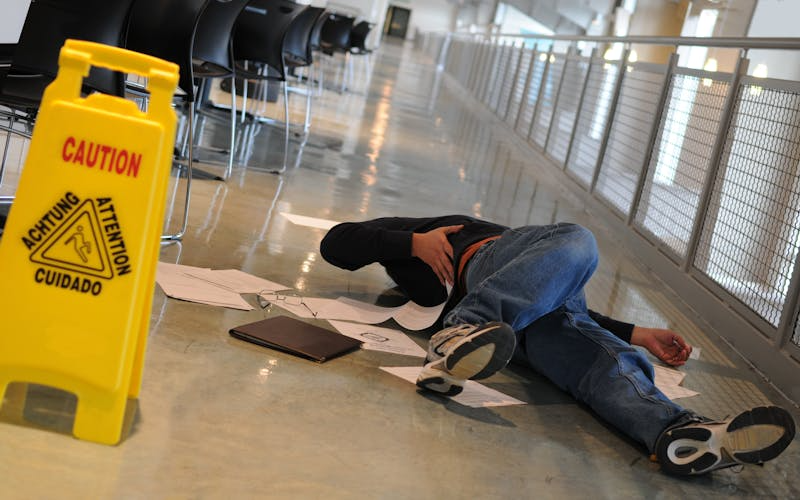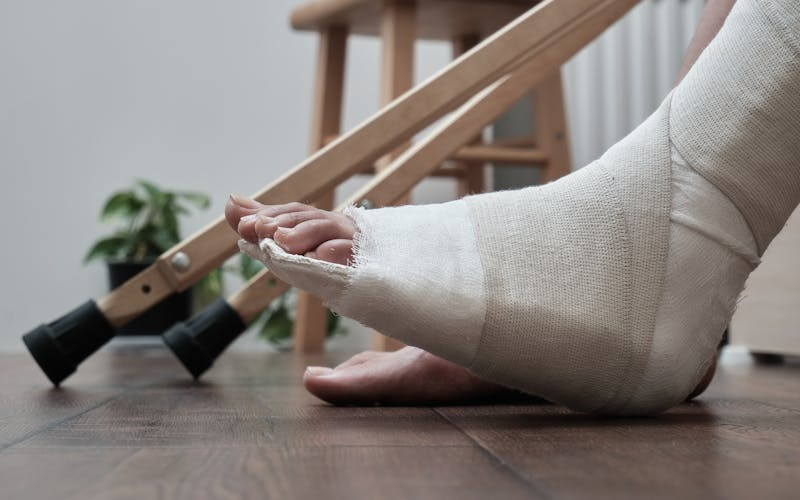
Written on December 22, 2023.
Written by James J. Kirshbaum. Posted in Premises Liability.
A slip-and-fall can happen in an instant, but the recovery process can last months or even years. In particularly unfortunate cases, you may even suffer permanent damage in an accident. However, no matter how severe your injuries are, you deserve proper compensation.
Personal injuries of all kinds can be unexpected and traumatic, but slip-and-fall injuries are particularly troublesome, considering the responsibility of property owners to maintain safe conditions for people. Whether you suffered a slip-and-fall at a business or a private residence, you deserve compensation, and the time it takes you to recover should be taken seriously.
A Minnesota premises liability attorney can provide you with legal representation while striving for the compensation you deserve. At Kirshbaum Injury Law, we will be by your side for every step of the healing process.
How Does Minnesota Define Slip-and-Fall Accidents?
A slip-and-fall in Minnesota is legally defined as an injury that is suffered due to a defect in a piece of property that created dangerous conditions. A spill on the floor of a supermarket, for example, could lead to a customer slipping and breaking their wrist. That would be a slip-and-fall accident because the floors of a supermarket should be safe for customers. Surfaces that are covered in ice and snow can also be potentially dangerous if the property owner doesn’t keep their pathways clear.
The Slip-and-Fall Statute of Limitations in Minnesota
If you are filing a slip-and-fall claim in Minnesota, you must abide by the state’s statute of limitations, which is six years from the date of the accident. While this may seem like a long time relative to some other statutes of limitation, it is still important to file as soon as possible.
Slip-and-fall accidents are more common than you might think. According to the Centers for Disease Control and Prevention (CDC), more than a million Americans are hurt from slip-and-fall accidents every year, resulting in over 17,000 accidental deaths.
Types of Slip-and-Fall Accidents in Minnesota

Slip-and-fall accidents can occur in many different settings in Minnesota, and they each have unique considerations to keep in mind, from minor injuries to more serious types of injuries.
Stores and Restaurants
Stores, restaurants, and other types of businesses that frequently have customers physically visiting the premises are common locations for slip-and-fall accidents. A floor could be wet from a spill or a leaking refrigerator, or entrance walkways could be slippery from winter slush. While not technically a slip, a trip-and-fall is legally treated the same way if you’re injured by equipment like boxes in walkways or worn carpets.
Personal Property
Slip-and-falls on personal property typically occur when you are visiting someone’s house or in their yard. When you are invited to someone else’s personal property, that invitation comes with the assumption that you will be able to traverse that property safely. Keep in mind, however, that you must be invited for this to apply. You cannot recover compensation for a fall you suffered while trespassing.
Warehouses and Workplaces
It is common for warehouse workers to fall and sustain injuries on the job, so companies are usually meticulous about their workplace safety practices. Even so, you may be entitled to workers’ compensation if you suffered a slip-and-fall at work.
Common Injuries Sustained in a Slip-and-Fall Accident
Slip-and-fall accidents can be more damaging than you might think. Here are some of the most common injuries in these kinds of accidents.
Neck Injuries
Injuries to the neck can be particularly severe, given that they can potentially lead to spinal cord damage.
Symptoms of Neck Injuries
- Nerve pain
- Headaches
- Muscle spasms
- Muscle pain
When to See a Doctor
You should see a doctor when your neck pain lasts for a long time without improvement or if your ability to move your neck and head is limited. Any kind of weakness in your arms may stem from a pinched nerve in your neck, which warrants medical attention.
Recovery Time Frame
The healing time for neck injuries depends on their severity. More extreme cases could have you facing months of recovery, while other kinds of neck pain will resolve in a matter of days. Seeing a doctor is the best way to determine your neck injury’s severity and recovery time.
Muscle Injuries and Tears
When you injure your muscles or suffer a muscle tear, the pain is only the beginning of the trouble, as your mobility could also be compromised.
Symptoms of Sprains or Strains of Muscles, Tendons, or Ligaments
- Muscle pain
- Tenderness in muscles
- Cramps and spasms
- Muscle “pop” during the injury
- A gap in the outline of the muscle
- Decrease in muscle strength or loss of function
- Muscle discoloration or swelling
When to See a Doctor
If your muscle pain does not improve after 48 hours, you should see a doctor. Some cases warrant immediate medical attention, like if you hear or feel a “pop” in your muscle during the injury. You should also see a doctor if your muscle is notably weak or difficult to move. You may also need to see a physical therapist.
Recovery Time Frame
For minor muscle sprains, you may find relief in as little as 48 hours. All symptoms may fade in a matter of two weeks or so. Back muscle pain tends to take longer to recover from, between four to six weeks. Severe muscle pain may last until the muscle is repaired surgically, and tissue damage can take months or longer to heal.
Concussions and Traumatic Brain Injuries (TBIs)
From concussions to traumatic brain injuries, head injuries are serious conditions you could suffer in the wake of a slip-and-fall.
Symptoms of Concussions and TBIs
- Headache
- Blurred vision
- Difficulty speaking
- Difficulty moving
- Nausea and vomiting
- Fatigue
- Drowsiness
- Dizziness
When to See a Doctor
You should see a doctor whenever you get a head injury of any kind. What you may think is a mild concussion could be a serious traumatic brain injury if left untreated, so seeing a doctor is paramount. Simply taking an over-the-counter anti-inflammatory and applying an ice pack is often not enough, so it is better to play it safe.
Recovery Time Frame
A mild concussion takes a few days to get over, but a traumatic brain injury can take much longer. In fact, more serious injuries can create lifetime conditions that victims have to learn to manage.
Broken Bones and Fractures

A broken bone can be incredibly painful and significantly limit mobility after a slip-and-fall.
Symptoms of Broken Bones and Fractures
- Sharp pain at the injury site
- Injured area is misshapen
- Inability to move affected part of your body
- Numbness or tingling in injured body part from interrupted blood flow
When to See a Doctor
You need to see a doctor for any instance in which you suffer a broken bone or fracture. Medical attention is necessary to help the affected bone heal correctly.
Recovery Time Frame
Broken bones typically take weeks to months to heal fully. However, the timeline for healing depends on the severity of the injury and which bone or bones were broken. In cases where surgery is required, recovery may take longer.
How Long After a Slip-and-Fall Accident Should I Be Sore?
Every slip-and-fall injury is unique, as are the people who suffer them. There is no universal answer to how long your soreness will last. Everyone’s body is different, as are their injuries. In general, fractured bones take a couple of months to heal, while severe injuries of a body part may take up to a year. New strength from soft tissue repair after a soft tissue injury can take more than a year to develop. Some injuries can last a lifetime.
What to Do Immediately After a Minnesota Slip-and-Fall Accident
In the wake of a slip-and-fall accident, here is what you should do:
- Seeking proper medical attention.
- Once any necessary emergency services are notified, do what you can to document the scene. Take photos of your injury and the property conditions that caused the injury, as this can serve as valuable evidence in your case.
- Call a Minnesota personal injury attorney to start your case.
Frequently Asked Questions About Minnesota Slip-and-Fall Accidents
How Long After a Fall Can I Claim a Suit?
From the date of the fall, you have six years to file a suit in the state of Minnesota.
How Are Damages Determined After a Slip-and-Fall Accident?
Damages are divided into economic and non-economic categories. Economic damages are easily quantifiable and include healthcare bills, X-rays, physical therapy, and lost wages. Non-economic damages are a bit more obscure because they reference emotional trauma and pain and suffering. A lawyer can help assign a reasonable figure for non-economic damages.
How Long Will It Take for My Personal Injury Case to Be Resolved?
The length of your case depends on how complex it is and the parties involved. These cases generally range from three to six months, but those that go to trial take much longer.
Your Trip-and-Fall Accident Matters. Are You Ready to File Suit?
With help from Kirshbaum Injury Law, you can focus on recovering from your injuries while we take care of your legal issues. We do not simply strive to win you compensation. We strive for the maximum compensation. Contact us today at 952-545-2700 or by filling out our online contact form for a free consultation with an experienced Minnesota premise liability attorney.

Written By James J. Kirshbaum
Jim is a very experienced trial lawyer having conducted jury trials in multiple states both on behalf of injured people and on behalf of defending insurance companies.
Schedule a Free Consultation with James J. Kirshbaum



